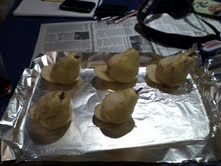I awoke this morning feeling strangely
oriental. Therein, I decided it was time to make some Hoi Sin
chicken.
Hoi Sin comes from a Cantonese word
meaning 'sea food'. Luckily, for both my family and the chicken, Hoi
Sin sauce contains no maritime ingredients. Rather, it is a
starch-heavy mixture usually containing soy beans. 'Why the nautical
etymology?' you may ask, to which I have no reply.
In order to make Hoi Sin chicken one
first must acquire chicken. 8 thighs should do, but any cut is
acceptable. The sauce should be made of ¾ a cup of Hoi Sin sauce, 1
teaspoon of ginger, many cloves of garlic, a teaspoon of pepper
flakes, ½ teaspoon of sesame oil, a tablespoon of soy sauce, one
of rice vinegar and a secret ingredient that shall be discussed
later.
When preparing a meal from the orient,
it is always good to be prepared with a bag of rice so snooty that
even the most pedantic of Confucian scholars would bow there heads,
lower than Ran Qiu, in shame (look it up). Though the Chinese (that
are probably not reading this) would curse at the ambiguity, I used
Kagayaki rice, a Japanese favorite.
I should clarify that I do not
randomly know my brands of oriental rice. A few years ago my
liberal-minded family befriended another nice family of similar
customs. The friendship, my mother's doing, was struck up with a
Jewish-Japanese couple from America's Red State: Massachusetts. These people first introduced us to Kagayaki rice, which is
much better than normal rice. They are also responsible for the rice
cooker in which I cooked the rice.
The rice cooker takes about thirty minutes to complete its eponymous duty.
Thus, I proceeded to mix the aforementioned ingredients in a large glass bowl. The ginger, which must be finely minced, presented the biggest problem. Though I am sure there exists a device for properly mincing ginger with minimal effort, I did not own such a contraption, and, therefore, was forced to use a tomato knife. The tediousness of this task caused me more distress than a Buddhist during the Han dynasty. However, once the minced garlic and other ingredients were added, they assimilated better than the Mahayana.
The Sauce:
China is a land of many ancient secrets, and so was my chicken sauce. However, for you, my faithful blog reader, I shall reveal its secrets. Don't tell anybody.
What made my Hoi Sin sauce so good? A little extra something: lots of chili powder. For those thinking of Jesse Pinkman, yeah, I stole the idea. Chili powder goes with anything!
Another trade secret is to add just a dab of Japanese peanut sauce. Again, not something usually found on Chinese mainland, but what they hey.
I then lavishly applied my sauce to the chicken, placed on tinfoil in a 1'' deep pan, ready for cooking.
The oven should be preheated to 500 degrees and expected to cook for 20-30 minutes.
The final piece to the puzzle was to find a green. Here, I thought it would be okay to settle for a little Americanization. I fried up some green beans, but, in an effort to get that blend of East and West culinary heritage first popularized by Blade Runner, cooked it in the aforementioned (2X!) peanut sauce.
Green beans are a lot like the Sui dynasty; though the action of cooking them is short-lived, people often underestimate the significant impact they have on the development of the meal.
Here is the chicken, ready to be served:
Here's the full meal on the table:
I sincerely hope this article has been informative, both in the culinary arts and (maybe a little) in Eastern culture. It is far too often we Westerners become lost in our self-contained worlds of golf carts, Roman heritage and shopping sprees. We often forget the thriving metropolis that is, and has been, Eastern civilization. China, the oldest continuously existing civilization, has been nagging at our conscious of late. But, in our intolerance of centuries before the American revolution, we forget that there was a time before the sun never set on the British Empire, when it damn near never set on China's. Their culture is a rich one, full of as many artistic and poetic triumphs as the Renaissance, as well as the technological and philosophical innovation to match. I leave you, good reader, with the pinnacle of Eastern culture as it has most recently re-defined itself. Enjoy:
























